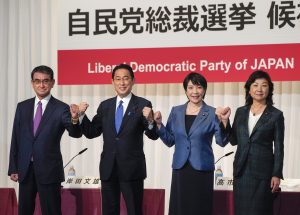Every few years, Japan goes through a rite that momentarily captures the attention of Japanese politics aficionados all around the world: the election of the leader of the country’s long-ruling Liberal Democratic Party. Needless to say, the flurry of articles, news clips, and commentary about candidates and proposals in the last couple of weeks is indication that the season is upon us. Given the unusually open field, the pandemic, multiple female candidates, and the imminent general election, the contest this time is particularly fascinating and potentially pivotal.
As a historian, I view these events not only as an ordinary person interested in politics but as someone who reflexively draws connections to the past. While it is far from the most consequential aspect of the LDP presidential election, I am always fascinated when I ponder the backgrounds and formative influences of the candidates – a particularly rich trove of information, given the powerful role of factional lineages and dynastic politics in Japan and particularly among politicians in conservative or centrist parties.
In the most obvious example of how this historical perspective can provide intriguing insights the 2009 general election featured a showdown between Aso Taro and Hatoyama Yukio, respectively the grandsons of Yoshida Shigeru and Hatoyama Ichiro, archrivals in the early postwar period. Just like their forebears, Aso and Hatoyama competed not as adversaries within the same party but as the heads of two large, heterogeneous parties with a great deal of ideological overlap.
Though less simple and less stark, the interesting analogies continue in this upcoming contest. The four candidates for president each represent a distinct constituency or stream within the ruling LDP.
Kono Taro is both a popular and quirky figure, resembling in uncanny ways his father Kono Yohei but especially his grandfather Kono Ichiro. Though known as a master of factional politics, Ichiro was also an otherwise capable politician who exerted himself on particular projects such as normalizing Japan-Soviet relations and preparing for the 1964 Tokyo Olympics. We can see a similar entrepreneurialism in Kono Taro’s approach to digitization and work culture. A populist figure among the public, Kono Ichiro was also polarizing within the LDP, and came to be reviled by heavyweights like Yoshida Shigeru and Kishi Nobusuke, who at one point even called Ichiro a “communist” for his overtures to Eastern bloc countries. Today’s party elders Aso Taro and Abe Shinzo, descendants of Yoshida and Kishi, have lukewarm support, if not outright opposition, toward Kono Taro’s candidacy, despite the fact that Kono is a member of the Aso faction and served in key roles in the Abe administration. Yoshida would surely be surprised to learn that his grandson and his political foe’s descendent were in the same faction.
Kishida Fumio is also a hereditary politician. More importantly, he is the leader of a large faction, Kochikai, which is one of the most well-established and coherent in the LDP, with a storied legacy of producing technocratic prime ministers, from Ikeda Hayato to Ohira Masayoshi to Miyazawa Kiichi. Kochikai historically tended to be the most orthodox and least polarizing of the LDP’s subgroupings, which can also be said of Kishida in terms of his ideas and personal ties. If he prevails in the presidential election, it would probably be as a leader acceptable to the most members of the LDP, especially the parliamentary elites. However, it would be a notable achievement for the Kochikai and its brand of politics, which has not produced a prime minister since Miyazawa in the early 1990s.
Takaichi Sanae departs from the mold of a typical LDP leader in being both a woman and a truly self-made politician. However, she is firmly tied to the power structure in terms of being a protégé of former prime minister Abe Shinzo and through her ties with staunchly conservative organizations like Nippon Kaigi. In this sense, she represents relatively a new so-called “neoconservative” stream in the LDP that emerged in the 1990s. This right-leaning element has gained some traction during the Abe administration but is not dominant in the party or the broader political culture, which lessens Takaichi’s chances of prevailing in the race. But her candidacy can be seen as an attempt for the Abe circle and the Japanese right to build a bridge to a new generation of politicians and reach out to new constituencies.
Like Takaichi, Noda Seiko would bring gender diversity to Japan’s leadership, but the similarities between the two end there. Though she is a hereditary politician, Noda is not affiliated with a faction, nor is she backed by any powerful powerbroker or constituency. She even left the LDP briefly over differences with Prime Minister Koizumi Junichiro’s policies. Besides the lack of institutional backing, she has a unique profile as a female politician who raised a special-needs child. Furthermore, her positions on social issues are quite progressive within the center-right LDP. Thus, there is little historical baggage to draw upon to discuss her candidacy, other than to say that it faces long odds. Of all the contenders, her improbable victory would represent the biggest change in the LDP – completely uncharted territory – but would also inevitably incur a strong resistance within the party.
All these historical considerations make the upcoming LDP presidential election particularly interesting to watch. Certainly the selection of the first female leader of Japan’s ruling party would be historic and have potentially significant implications for Japanese society. However, Kono Taro is also a singular political figure who could shake up Japanese politics, and even Kishida Fumio would bring a departure in style and ideology from the Abe-Suga line of the last near-decade.
Yet in light of this anticipation its important to keep in mind that the change in LDP leadership comes on the eve of a general election, the real opportunity for ordinary citizens to shape the direction of Japanese government.
































